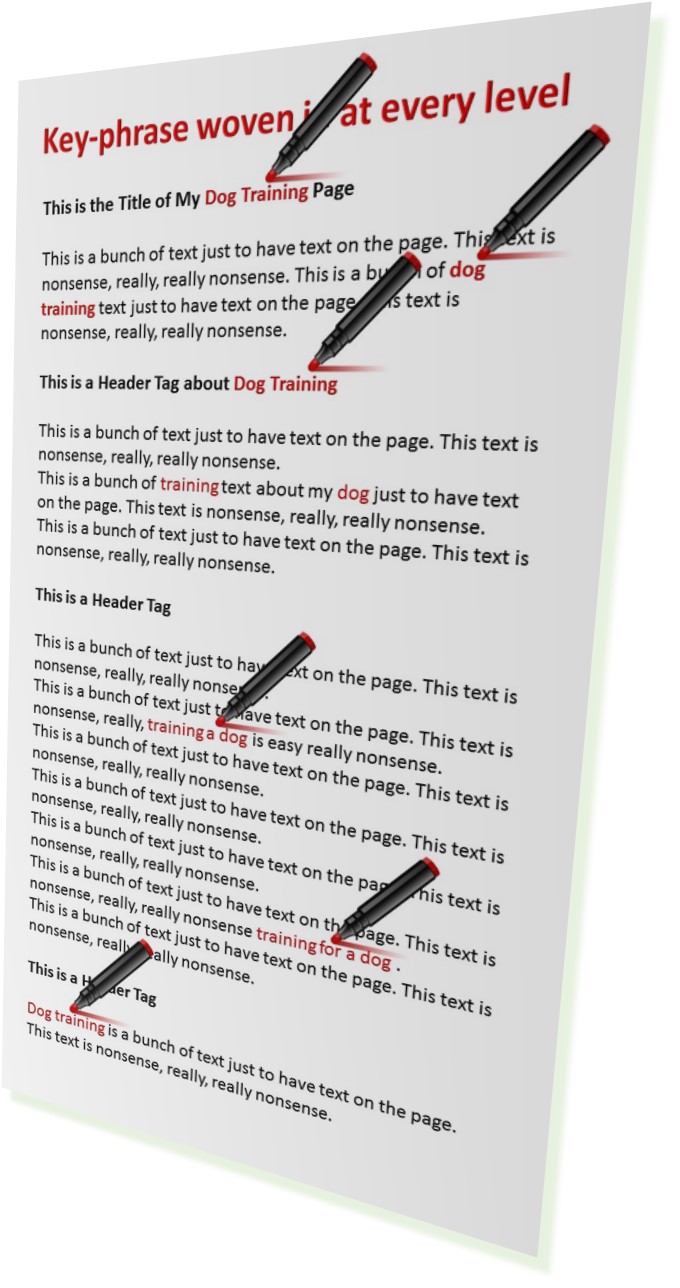SEO Checklist 2017
SEO Checklist – Have you done everything you can to rank your page?

Doing a good job with ALL these SEO checklist techniques will set you apart from most competitors and most SEO’ers.
Doing a good job with all these SEO techniques will set you apart from most competitors and most SEO’ers. Most people are lazy (SEO’s you are competing with) and simply do not follow through with all these checklist items. We have demonstrated time and again that getting them right, will significantly boost a page’s visibility in 2017.
Image SEO
Adding images (assuming they are appropriately highly optimized) can make a big difference to how a page ranks and also make the page that much more interesting. Image search can also be a major source of traffic if your images rank independently on your page. There is a reason why images are first on the SEO checklist.
As part of your page development or as an update to your page, you should add lots of original images whenever possible (use screenshots of any videos?). In general, people put too few images on a page and make them too small. Try to avoid any large segments of text without an image… The more images the better.
Key-phrase and testing
What exactly are you optimizing your page for? Have you put that phrase into a rank tracking tool such as SEMrush or similar, to see if you are getting a result over time?
- Have you manually Googled your phrase to see what Google tells you are closely related phrases and to see how your content is actually ranking?
- Have you performed an image search to see if your images are ranking for the primary key-phrase?
- Have you put a reminder in your calendar to remind you to do this at various times in the future?
You can learn more about what works and what does not, by tracking and seeing for yourself, than by any other method.
Key-phrase Optimizing

And the Google God proclaimed, “make it obvious as to what your page is about if you want it to rank”.
There should be no doubt what you are trying to rank a page for. In most cases, you should have one key phrase per page you are trying to rank for. One thing that you are working through your SEO checklist to weave into your page. Be sure you have your primary key-phrase is woven into every level of your page:
- The Title Tag
- The Description Tag
- The Key-phase Tag
- The URL (note SEO checklist is in the URL for this page)
- The Page Title / H1
- Woven into the article – as a rule of thumb it should be in the
- Page Summary
- Body text
- Article Concluding Summary
- The Call To Action (CTA)
- One or more of the heading tags
- Images & Videos
Onsite Inter-page Linking – Incoming
Make sure you have found at least three (generally the more the better though) other pages on the site where you send a link to your page using the phrase you want it to rank for. This is one of the most common SEO checklist items that is missed. Use the exact phrase or a very close variant. There are some simple techniques for doing this if it is not so easy to insert or find your key-phase in the page’s text. For example, you can add a simple CTA line of text at the bottom of a page, i.e. “Learn about SEO the fast way see our “SEO Checklist” Where SEO Checklist would be a link to this page in this example. Or you could add an image CTA with a link that does the same…
Onsite Inter-page Linking – Outgoing
Every time you create a new page on a site, it is an opportunity to boost the ranking of existing pages, by sending links to them. This however can be overdone. Make sure your links make sense, add value to the reader’s experience, and don’t go over the top. Do not send multiple links to the same page. As a rough guideline, aim for no more than 5 links per 1,000 words – you can do more than that if, for example, you have lots of technical terms on a page, however, that is a good ratio to aim for…
Linking to External Sites
Believe it or not, links going to external sites (outgoing links) can enhance the value and authority of a page. No SEO checklist 2017 item is complete without this. For this technique, context is everything. For example, if your article mentions a business, restaurant, location, service, or unusual subject, an outgoing link to it can help the reader to better understand whatever you are referring to. In general outgoing link should open in a new window, so that you do not actually drive the reader away from your site.
Navigation
When you add a blog post to your site, navigation is usually created automatically. However, when you create a page, it’s important to remember to manually add navigation to your page. The text of the navigation makes a difference. Where on the site you put the navigation, makes a difference. Google will not find your page if you forget to add navigation to it. Nor will users…
Definitions
Add a good clear concise definition of whatever term is central to your article. Google is sometimes providing these within the search results. Doing this can significantly boost a page’s visibility. Generally, the best way to do this is to first ask the question, then answer it in the most concise and clear way you can. In general, the best definition wins. To understand this better search in Google asking specific questions to see this in action. To see an example, Google the phrase, “what is spray foam insulation“.
Social & Business Listings
Info-graphics and any and all images you put on a page can be boosted by posting them on social sites and business listing sites and then and linking back to the page. There are a lot of social and business listing sites that are great for this. A few examples are Pinterest, Facebook, Houzz, Instagram, Google My Business, Yelp, Travelocity, and many more. For Pinterest specifically, one good SEO checklist technique is to create an original image set by stacking several on top of each other to create a single tall image. This creates a new original image using existing images also tall narrow images tend to stand out on Pinterest. You can also add a text overlay with a catchy message or a CTA to your image to make it stand out and attract more clicks…
Phasing
While it is not always possible to do this, phasing in content is much more effective than making a page perfect in one go. The more times you update a page with fresh content, the better. We have been able to dramatically boost a website by simply going in and adding content to every existing page on a weekly basis. Do not underestimate this technique.
As a very rough guideline phases can look like this
Every week
- Phase in text in 500-word segments
- Phase in images 2-3 at a time
- Add video(s)
- Enhance with on-site inter-page linking
- Enhance with incoming off-site links
Remember also that every time you go back and do something along the lines of the above suggestions, it is also an opportunity to communicate that fact to the client boosting their perception of the value they get from us…
Advanced – Extras
Understanding Rank Brain
InfoGraphics
Can you create an info-graphic summary of the key points of your article? This can add a lot of value to a page, visually for the reader to memorize and it encourages and provides an easy way to share your article. You can also post your info-graphic on web 2.0 sites such as Pinterest, Houzz, Travelocity, and many more…
Graphic CTA’s that are highly optimized
Page Load Speed
Off-site incoming links
Page-Specific Link Outreach
Highlighting Key Points
Write for and Format for Scanners and Speed-readers
Video
TOC (Table of Contents)


